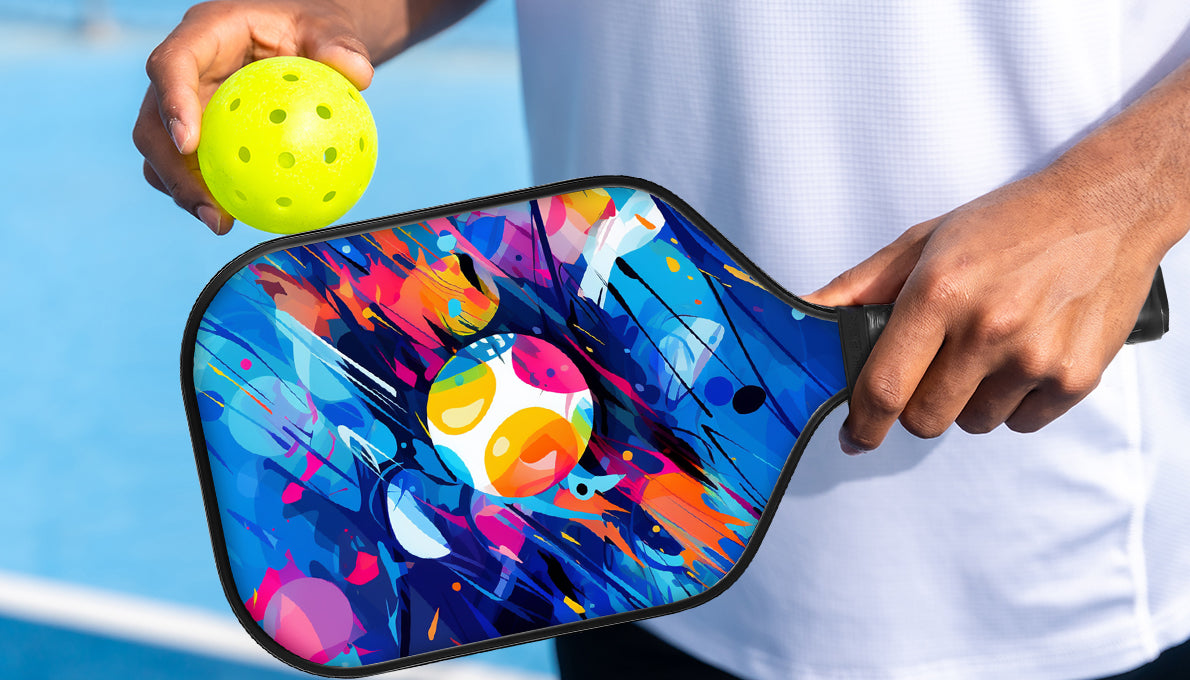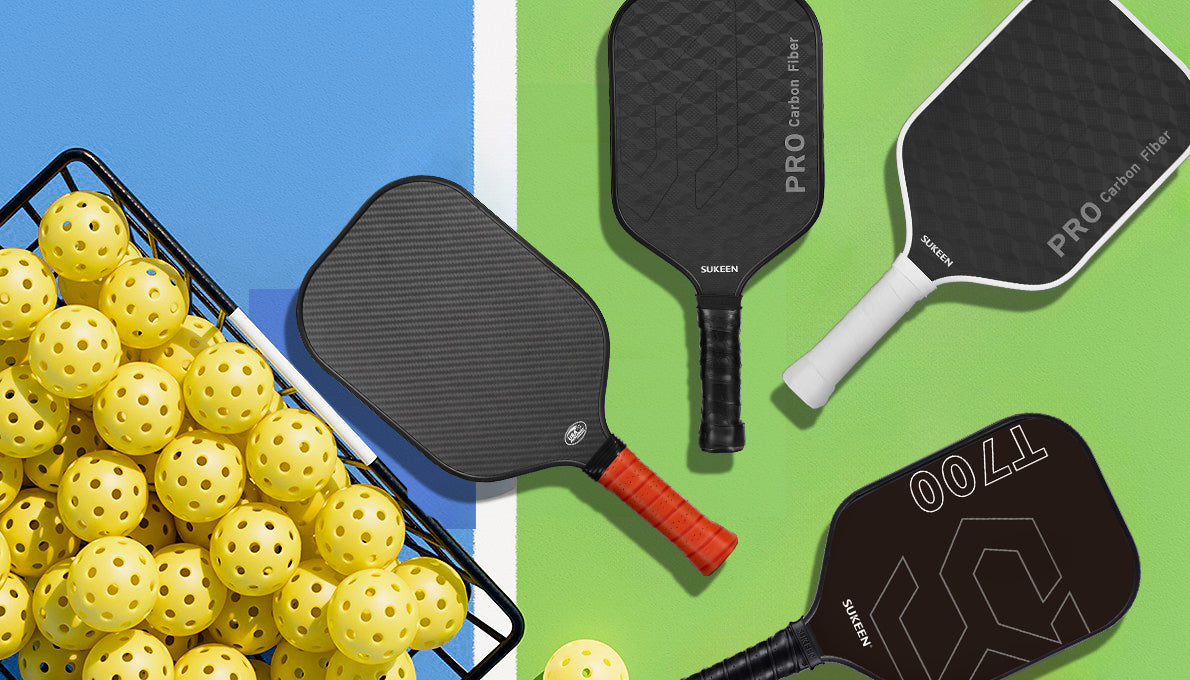Pickleball Paddle Choice Between Different Thicknesses
Ⅰ. Factors that determine thicknessⅡ. Paddle ShapeⅢ. Professional players' opinions on choosing paddle thicknessⅣ. User pain points and solutionsⅤ. Professional players' choice of thickness
Have you found that the thickness of other people's rackets is different from yours? The feeling of trying it out is like opening the door to a new world. As a professional player, I know that the thickness of the racket is crucial to the feel and control of the shot. Racks of different thicknesses will bring completely different experiences and effects.
The thickness of the racket directly affects the strength and stability of the racket. When making precise ball placement or dealing with strong backspin in the game, I tend to choose thicker rackets because they can better absorb the power from the opponent and keep the direction of the ball. In addition, the feel and feedback of the shot are also considered when choosing the thickness of the racket.
Ⅰ. Factors that Determine Thickness
1. Material selection
The thickness of the racket is directly affected by the material it is made of. Different materials, such as carbon fiber, fiberglass or composite materials, will affect the structure and thickness of the racket. Generally speaking, using stronger and more durable materials will increase the thickness of the racket. Carbon fiber is often used to make lightweight and strong rackets, which can achieve a thinner design without losing strength. If you want to know more about materials, you can read What is the best material for a pickleball paddle?
2. Design and structure
The design and structure of the racket will also affect its thickness. The shape of the racket frame and the design of the internal structure will affect the overall thickness and weight distribution of the racket. For example, some rackets may use a reinforced frame structure or special vibration damping technology, which may increase the overall thickness of the racket while improving its performance and comfort. Thickness has a certain impact on the overall weight of the racket. When considering thickness, you can consider the weight factor. You can read What Pickleball Paddle Weight is Right for Me? to find the right racket weight for you.
3. Market demand and trends
Manufacturers usually adjust the design and thickness of the racket according to market demand and trends. With the advancement of technology and the improvement of manufacturing processes, racket design has become more and more refined. Advanced manufacturing processes can achieve a lighter and thinner design while ensuring the strength and durability of the racket to meet the player's needs for speed and flexibility.
Paddle thickness is one of the factors to consider when choosing a racket. You should also consider other aspects to determine whether a racket is suitable for you. You can refer to What to Look for in a Pickleball Paddle?
Ⅱ. Paddle Shape
Different types of racket frame shapes are usually closely related to the thickness of the racket, and they jointly affect the performance and applicable scenarios of the racket. The following is the relationship between different types of frame shapes and thicknesses.
1. Classic Shape
The classic frame is usually suitable for rackets of various thicknesses, including 13mm, 14mm and 16mm. This frame shape is usually a round or nearly round design, providing a relatively balanced performance and suitable for a wide range of players. Whether it is a 13mm thick racket, which provides a larger point hitting area, helping to increase the sweet spot and stability of the shot, or a 14mm thick and 16mm thick racket, both provide better control and stability.
2. Mid-wide Shape
Mid-wide frames are usually more common with 14mm and 16mm thick rackets. This design slightly increases the hitting area compared to the classic frame, bringing a larger sweet spot and stability, suitable for players who prefer control and stability.If you want to know more about the sweet spot, you can read "Pickleball Paddle Sweet Spot Guide".
3. Extended Length Shape
Long frames are often used for players who need extra power output and a larger hitting area. This design can be combined with 14mm and 16mm thickness rackets to enhance power and control.
4. Wide Body Shape
Wide frame rackets are often combined with 13mm and 14mm thickness rackets. This design adds width to the sides of the frame, providing a larger hitting area and stability, suitable for players who prefer power hitting and need a large sweet area.
5. Other Special Shapes
Other special shapes of racket frames, such as oval or square, may be combined with rackets of different thicknesses to meet specific technical needs or personal preferences. These designs usually differ in hitting feel and performance characteristics, and you can choose the racket that suits you according to the specific situation.For more information about racket shapes, click " The Shape of the Pickleball Paddle" to learn more.
Ⅲ. Professional Players' Opinions on Choosing Paddle Thickness
When choosing a pickleball racket, thickness is an important consideration. Rackets of different thicknesses have their own characteristics in terms of performance, control and comfort. This article will explore 13mm,14mmand 16mm thickness rackets in detail to help you find the one that suits you best.
1. 13mm Thickness Paddle
Ball Hitting Effect
13mm thickness rackets are thinner types. 13mm thickness rackets can provide faster swing speed and faster ball speed, with more sensitive touch and feedback, and can more accurately perceive the racket position and hitting point when hitting the ball, thereby enhancing the ability to control the ball.
Power
Similar to 14mm rackets, the power is relatively weak and requires certain skills to make up for it.
Thinner rackets may use lighter and higher-strength materials to keep the racket lightweight and flexible.
Use Scenarios
Suitable for precise control-- players who like to control the rhythm of the game and hit the ball accurately.
Suitable for fast games--In fast-changing games, the lightness of 13mm rackets is an advantage.
Professional Advice
Recommended users-- intermediate and advanced players who emphasize control and speed.
Recommended products-- SUKEEN's 13mm ultra-light series rackets, combining lightness and high control.
2. 14mm Thickness Paddle
Power
Due to the thin thickness, the power when hitting the ball may be relatively weak, requiring a higher level of skill to control.
Hitting Effect
14mm thickness rackets can provide faster swing speed and faster ball speed, but may be slightly lacking in power and stability.
Usage Scenario
Suitable for offensive players-- Players who like fast attacks and quick reactions can choose 14mm thickness rackets.
Suitable for doubles mode-- In doubles, frequent position changes and quick reactions are required, and 14mm rackets can provide better flexibility.
Professional Advice
Recommended users-- offensive players and intermediate and advanced players with a certain level of skill.
Recommended Products
SUKEEN's 14mm carbon fiber racket series, providing lightweight design and high control performance.
3. 16mm Thickness Paddle
Power
Increased thickness brings stronger hitting power, suitable for players who need to hit the ball hard.
Hitting Effect
16mm thickness rackets are outstanding in power and stability, suitable for singles mode and long-term competition. Rackets of this thickness usually provide the highest level of stability and control, helping players reduce mistakes at critical moments.
Usage Scenario
Suitable for power players-- players who like to hit the ball hard and control for a long time.
Suitable for Singles Mode
In singles, stronger power and stability are needed, and 16mm rackets can provide better support.
Others
With very good arc control ability, players can easily generate and adjust arc balls.
Professional Advice
Intermediate and advanced players who need stability and power.SUKEEN's 16mm thick series rackets, emphasizing power and stability.
Different thicknesses of rackets can significantly affect their performance in terms of strength, flexibility, and feel.
13mm Thickness Paddle
Compared to 14mm thickness, 13mm thickness rackets may be slightly inferior in strength. The thinner frame makes them more susceptible to the pressure of hitting the ball, so they need to be used more carefully to avoid damage. But they are more flexible than 14mm. This is also because this design can increase the reaction speed of the racket, making it easier for players to react and adjust quickly during the game.
14mm Thickness Paddle
Generally speaking, 14mm thickness rackets perform better in strength. Because thicker frames can better resist stress and distortion when hitting the ball, this type of racket usually provides a stable structure that is not easy to deform or break. Thicker frames generally reduce the flexibility of the racket.
16mm Thickness Paddle
16mm thickness rackets generally have the highest strength level. Its thick frame design can effectively withstand greater impact forces and is suitable for players who like to hit the ball hard.

Ⅳ. User Pain Points and Solutions
When choosing the thickness of a racket, users may encounter the following confusions
1. How to balance control and power?
Choosing a racket with a thickness of 14mm and 13mm can provide higher control, but may require a higher level of skill to make up for the lack of power. A racket with a thickness of 16mm provides stronger power, but the weight may increase the burden on the wrist.
Solution
Choose a racket thickness that suits your playing style, and improve your skill level through continuous practice.
2. Comfort for long-term use?
Using a heavier racket for a long time may cause wrist fatigue.
Solution
Choose a racket that fits your hand feel, and use SUKEEN's comfortable grips (such as overgrip and replacement grip) to improve comfort.This article "What Should you Know about Changing your Pickleball Paddle?" talks about grips in detail, including how to choose one.
3. Balance between quick response and stability?
In fast-changing games, thinner rackets can provide better flexibility, but may lack in power.
Solution
Choose the right thickness according to the type of game, and find a balance between quick response and stability.
Ⅴ. Professional Players' Choice of Thickness
Ben Johns
Ben Johns usually uses a thinner racket, about 13mm to 14mm. He likes to use a lightweight and highly flexible racket to help him show quick reactions and delicate technical shots on the court.
Tyson McGuffin
Tyson McGuffin tends to use a slightly thicker racket, usually between 14mm and 16mm. His racket design focuses on providing stability and power output, which is suitable for his powerful hitting style.
Simone Jardim
Simone Jardim usually chooses a medium-thick racket, about 14mm. As a member of the women's professional court, she needs a racket design that balances control and power to cope with various game scenarios.
Kyle Yates
Kyle Yates prefers to use a thinner racket, usually between 13mm and 14mm. He likes fast swing speed and precise control, so he chooses a racket design with high lightness and flexibility.
After learning about the thickness of the racket, I believe you also have your own understanding of the thickness. Different racket thicknesses have different usage feelings, performance emphasis, and applicable scenarios. Racks of different thicknesses have their own advantages and disadvantages. Considering your own playing style, technical level, and competition needs, choosing the most suitable racket thickness will bring significant improvement to your game career.
Related Articles
A Guide to Pickleball Paddle Edge Guard Types The Secret of the Thermoformed Pickleball Paddle
Best Pickleball Paddle Under $100 Pickleball Paddle Core Construction
Mastering Pickleball with Lead Tape







